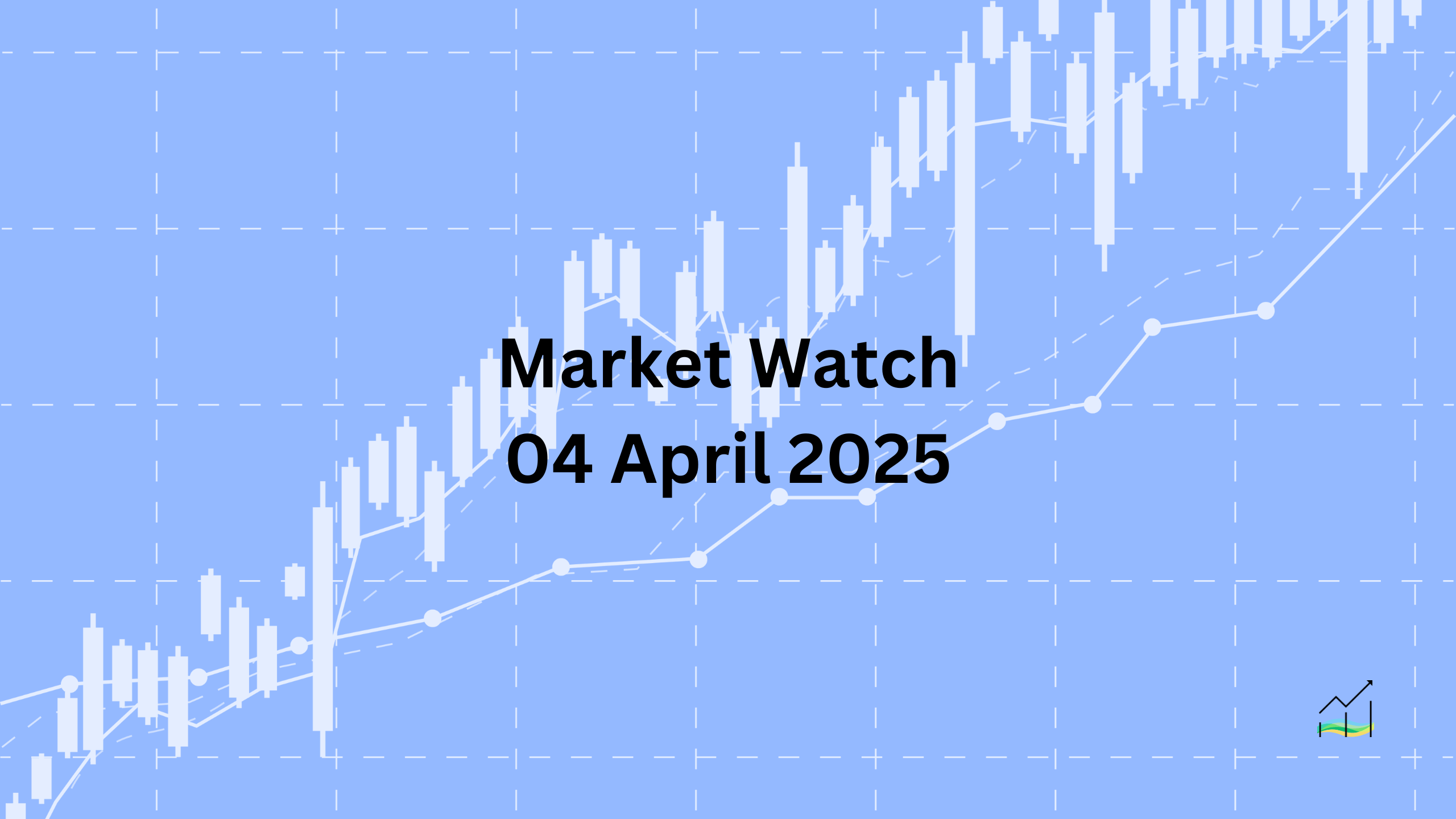04/04/2025 Market Watch

Tariff Tensions & Jobs Data Drive Dollar Recovery
The US dollar is finding renewed strength, supported by a mix of geopolitical maneuvering and cautious repositioning in financial markets. One major factor is the uncertainty surrounding reciprocal tariffs. Market participants are debating whether these tariffs are genuine policy tools or strategic leverage in ongoing negotiations. President Trump's comment about being open to "phenomenal offers" reinforces the idea that this could be a tactical move rather than a fixed direction. However, the inconsistency of applying tariffs—such as the case with Israel, which removed all duties on US imports but still faced a 17% tariff—adds complexity to the situation and raises questions about the broader policy logic.
Another contributing factor is market positioning ahead of the US employment report. While some survey-based indicators suggest softening in the labor market, more concrete data like weekly jobless claims haven't fully confirmed a downturn. However, the continued rise in ongoing claims is consistent with a gradual slowdown in hiring. Shortly after the employment report, the Federal Reserve Chair is expected to speak about the economy. Although his remarks may stir volatility, it's unlikely he will imply any immediate response to equity market movements, avoiding the perception of a "Fed put" where monetary policy is adjusted in reaction to falling stock prices.
Broader financial markets are reflecting caution. The US dollar is stronger against nearly all G10 currencies except the Swiss franc. European factory data disappointed, while Japan’s central bank acknowledged growing global uncertainty. Emerging market currencies are mixed, with those in the Asia-Pacific region performing better than central Europe. The Chinese central bank set the dollar reference rate at its highest level this year. Equity markets are under pressure, with most indices declining and US futures pointing to a weaker open. Bond markets remain a safe haven, with US and European yields falling sharply and risk premiums widening. Commodities are not immune to the volatility—gold is trading lower despite its usual safe-haven status, and crude oil prices continue to fall following OPEC+’s larger-than-expected sales increase and broader growth concerns.
United States of America
Overview
The US dollar experienced a broad and aggressive sell-off, marking its steepest daily decline since late 2022. The Dollar Index (DXY) dropped nearly 1.7%, falling from highs near 104.30 to lows around 101.25 before recovering slightly above 102.00. The sharp move pushed the index below three standard deviations from its 20-day moving average during most of the European and US trading sessions—an extreme occurrence suggesting heightened volatility. This move comes amid ongoing global reactions to US trade policies and questions about the sustainability of US growth strategies. While GDP and household net worth are at record highs, the approach increasingly resembles a short-term extractive strategy rather than long-term economic leadership.
Economic Drivers
Broader macroeconomic themes are reshaping investor sentiment and undermining dollar strength. Despite claims of external disadvantage, the US has continued to outperform global peers by most economic metrics.
- The US economy is at its largest in history, with household net worth at record levels.
- Instead of growth-driven policy shifts, the current economic direction resembles a resource-extraction model, drawing comparisons to historical empires using wealth redistribution tactics.
- Market participants are reassessing the long-standing narrative of “US exceptionalism,” which has underpinned strong dollar expectations for years.
Data and Events
Investor attention has now shifted toward labor market data and key policy communication, both of which are expected to influence short-term market direction.
- Nonfarm Payrolls (March) – Forecast to rise by 140k (compared to 151k in February), with the private sector contributing an estimated 135k (140k prior).
- ADP Employment Report – Showed stronger-than-expected growth at 155k jobs, but not expected to be mirrored in official nonfarm payroll figures.
- Unemployment Rate – Currently at 4.0%, with a slight increase considered likely.
- Jobless Claims – Weekly data, including figures for federal employees, still show minimal signs of labor weakness.
- Fed Chair Powell’s Speech – Scheduled for about four hours after the payroll release; markets are watching for any policy signals.
- Market Expectations for Rate Cuts – Futures now price in over a 90% chance of a Fed rate cut in June, up sharply from two-thirds just one week ago.
Price Action
The US dollar's decline triggered extreme technical signals, with the Dollar Index trading well below three standard deviations from its 20-day moving average for most of the European and North American sessions. Such a move is rare and points to intense selling pressure and momentum-driven behavior. After dipping near 101.25, the index managed to recover slightly above 102.00. A stronger barrier sits between 102.80 and 103.00, where sellers may regain control if upward momentum fades.
Key Points:
- The US dollar recorded its largest daily drop since November 2022.
- The Dollar Index moved into technically extreme territory, triggering a rebound from deeply oversold levels.
- Investors are reassessing US economic leadership amid signs of a more extractive economic approach.
- Labor market data and Fed communication are in sharp focus, with expectations of a June rate cut increasing.
- Technical resistance zones suggest limited near-term upside unless fundamentals shift.
Australia
Overview
The Australian dollar experienced a volatile session, trading within its long-standing two-cent range between $0.6200 and $0.6400, before fully unwinding previous gains and slipping below the lower boundary. Although it briefly reached its highest close since March 19, the currency has now fallen to levels not seen since mid-January. At the same time, updated data on household spending shows resilient consumer activity, which complicates expectations for monetary easing. However, despite the strength in consumption, markets remain confident that the Reserve Bank of Australia (RBA) will move ahead with a rate cut in May.
Economic Drivers
Australia’s economic landscape shows signs of solid consumer spending, which typically supports growth and argues against immediate rate cuts. Still, expectations for monetary easing remain intact.
- Household spending rose 0.2% in February and 3.3% year-on-year.
- January’s monthly growth was revised upward from 0.4% to 0.5%.
- Q4 2024 saw average monthly gains of 0.6% — the strongest since Q3 2023.
- The 0.7% cumulative increase in January and February matches early 2024 levels.
- Stronger consumption may delay the RBA’s comfort in cutting rates, but current sentiment still leans toward easing.
Data and Events
Markets continue to focus on upcoming policy decisions and trade developments that could influence the Australian dollar’s direction.
- RBA Rate Decision – May 20: The futures market continues to price in a high probability of a rate cut. Last week, a 25 bp cut was seen as 70% likely. Now, there’s also a 20% chance priced in for a 50 bp cut.
- Tariff Correction – Australia & New Zealand: The White House clarified that the reciprocal tariff rate on New Zealand is 10%, matching Australia’s rate, correcting the earlier signal of a 20% charge.
Price Action
The Australian dollar’s recent movement highlights technical vulnerability. After briefly reclaiming ground and reaching its best close in weeks, it reversed sharply and fell below the key $0.6200 level—a price it had not closed below since January. The pair remains within its two-month trading range, but the downside break threatens to shift momentum. Further weakness could confirm a bearish breakout, especially if follow-through selling persists in upcoming sessions.
Key Points:
- AUD reversed sharply after briefly reaching a multi-week high.
- Price action broke below $0.6200, threatening a range breakdown.
- Household spending remains firm but hasn't deterred rate cut expectations.
- Markets are now considering the possibility of a 50 bp cut by the RBA.
- The US corrected its reciprocal tariff rate on New Zealand to align with Australia’s 10%.
Canada
Overview
The US dollar came under significant pressure against the Canadian dollar, dropping more than 1% to test levels last seen in December. The sharp decline reflects broader market anxiety surrounding recent tariff developments and their potential impact on Canada’s economic outlook. Although the Canadian employment report for March is somewhat outdated in light of the new trade pressures, markets are increasingly pricing in a rate cut as downside risks to the Canadian economy grow.
Economic Drivers
Concerns are rising that the recent wave of US tariffs could disrupt Canadian supply chains and tip the economy toward a potential recession. Economists are now discounting any near-term strength in Canadian data as likely short-lived.
- Trade-related shocks are seen as a major threat to Canada's economic momentum.
- Fears of recession have grown, with economists treating any short-term data strength as temporary.
- The Canadian labour market remains soft, adding to pressure on the central bank to ease policy.
- Unemployment was 6.1% in March, up from 6.6% in January and February, but below the 6.9% peak in November 2023.
Data and Events
Markets are closely watching upcoming central bank decisions and evaluating employment trends in the context of recent trade disruptions.
- Bank of Canada Rate Decision – April 16: Market pricing reflects a 55% chance of a rate cut, up from 33% just a week earlier.
- March Employment Report: Canada added 15.5k full-time jobs in the first two months of 2024 and 49k overall jobs during the same period. The labour data is viewed as outdated due to recent tariff risks.
Price Action
The US dollar's drop toward CAD1.4025 marks a significant shift in momentum, hitting its lowest point since early December. This decline tested the 50% retracement of the US dollar’s rally from last September’s low near CAD1.3420. The next key level is around CAD1.3945, representing the 61.8% retracement. Early signs of support have emerged near CAD1.4055, with intraday rebounds reaching nearly CAD1.4170 in European trading. Short-term resistance is seen at CAD1.4175, and a break above this level could open the path toward CAD1.4220.
Key Points:
- The US dollar fell sharply against the Canadian dollar, testing the CAD1.4025 level.
- Market focus is shifting to recession risks from new US tariffs impacting Canada's outlook.
- Canada’s job market remains soft, and past data is seen as less relevant amid recent shocks.
- Rate cut expectations for the April 16 BoC meeting have risen from 33% to 55%.
- Technical retracement levels suggest CAD1.3945 is the next downside target if the trend continues.
China
Overview
The offshore yuan experienced sharp intraday swings as the US dollar initially surged to a two-month high near CNH7.35 before retreating to a weekly low below CNH7.24. The reversal came amid broad weakness in the US dollar and a downgraded sovereign credit rating for China. Meanwhile, China's central bank signalled a firmer stance by setting the dollar reference rate at its highest level this year. Upcoming inflation data and central bank reserve figures may further influence sentiment, especially with deflationary pressures still in focus.
Economic Drivers
Recent developments have drawn renewed attention to China’s fiscal outlook and its vulnerability to external shocks, especially in light of ongoing trade tensions.
- Fitch downgraded China’s sovereign credit rating from A+ to A, citing rising public debt and vulnerability to US tariffs.
- The downgrade reflects broader concerns about fiscal sustainability driven by debt-funded stimulus measures.
- Fitch’s decision was made before the latest reciprocal tariffs were announced, indicating the downgrade may not fully reflect the latest risks.
- The People's Bank of China (PBOC) signalled firmness by fixing the yuan at its highest reference rate of the year (CNY7.1889).
Data and Events
Markets are looking ahead to key data releases from China, which will shed light on inflation trends and broader economic health.
- Foreign Exchange Reserves (March) – Due over the weekend; closely watched for signs of capital flow pressures.
- Lending Data – Scheduled for release next week; important for assessing credit expansion and domestic demand.
- Inflation Reports – April 11
- Consumer Price Index (CPI): Expected flat year-over-year after the -0.7% decline in January, which was seen as a statistical anomaly.
- Producer Price Index (PPI): Deflation expected to persist, with a forecast of -2.3% versus -2.2% previously.
Price Action
The offshore yuan saw wide swings, reflecting shifting sentiment around US dollar strength and Chinese fundamentals. After climbing to a two-month high near CNH7.35 in Asian trading, the US dollar reversed sharply, dropping to CNH7.2750 by late European hours and sliding further to below CNH7.24 today — the lowest level this week. The pullback marks a notable shift in short-term momentum as the yuan stabilised amid broader dollar weakness and PBOC’s tighter fix.
Key Points:
- The US dollar surged to a two-month high against the yuan before reversing sharply.
- Fitch downgraded China’s credit rating, citing rising debt and trade-related risks.
- PBOC fixed the dollar at the strongest reference rate this year (CNY7.1889).
- Markets await Chinese reserve data, lending figures, and inflation reports next week.
- CPI is expected to stabilise while PPI deflation is set to continue.
Europe
Overview
The euro surged to nearly $1.1145 during early North American trading before reversing sharply and closing near session lows below $1.1030. The currency briefly crossed above $1.1100 but quickly faced selling pressure. A mix of disappointing German factory data and position shifts ahead of the US employment report pushed the euro below the $1.10 mark, triggering stop-loss orders that accelerated the decline toward $1.0965. While the broader eurozone calendar remains light, national-level economic data has exposed uneven growth, and investor flows are showing little appetite for European equities despite outflows from US markets.
Economic Drivers
Eurozone fundamentals remain fragile, with industrial activity showing uneven performance across key member states. US-German bond spreads have also narrowed, reflecting shifting rate expectations.
- Germany's factory orders were flat in February, missing expectations following a revised 5.5% decline in January.
- French industrial output rose 0.7% in February, the first increase since September, led by a 1.4% gain in manufacturing.
- Spain's industrial production also increased 0.7%, though recent months saw a cumulative 2% drop.
- Italy's retail sales inched up 0.1% in February but remain down around 0.25% for the year to date.
- The US 2-year yield premium over Germany narrowed by 8 basis points in the past two days, the smallest gap in about a month.
- Despite outflows from US equities, European equities have not benefitted — the Stoxx 600 index is down 9.5% from its March high.
Data and Events
While the eurozone calendar is relatively quiet, the largest four economies have released critical real-sector data that paint a mixed picture of economic momentum.
- Germany – Factory orders flat in February vs. expectations for a rebound.
- France – Industrial production rose 0.7%, the first increase in six months.
- Spain – Industrial production also gained 0.7%, exceeding forecasts.
- Italy – February retail sales rose slightly but remain weak overall.
Price Action
The euro’s sharp intraday reversal reflects increased volatility and market sensitivity to macro data and positioning. After briefly touching $1.1145, the euro was pushed lower, failing to sustain levels above $1.1100. A break below $1.10 triggered stop-loss selling, extending the decline to around $1.0965. Momentum shifted quickly, with investors adjusting positions ahead of US job data and reacting to the latest European economic releases.
Key Points:
- The euro briefly hit a two-month high before reversing sharply below $1.1030.
- German factory orders disappointed, triggering a bearish shift in sentiment.
- Broad eurozone data showed slight improvement, but gains remain inconsistent.
- US-German yield spreads narrowed to their tightest in about a month.
- European equities continue to slide despite capital outflows from the US.
- Stop-loss selling accelerated the euro's fall once it dropped below $1.10.
Japan
Overview
The Japanese yen saw a sharp surge against the US dollar, rising over 2% in a single session alongside the Swiss franc. The move followed a steep sell-off in equity markets that also drove the US 10-year Treasury yield briefly below 4%—a level last seen in October. The yen’s gains reflect heightened safe-haven demand, unwinding of carry trades, and signs of soft domestic consumption, reinforcing its role as a defensive asset during times of volatility.
Economic Drivers
Japan’s fundamental backdrop remains subdued, with weak consumption data despite supportive factors like low unemployment, rising wages, and government subsidies. At the same time, global risk aversion is driving capital back to low-yielding, traditionally safe-haven currencies like the yen.
- Japanese household spending fell 0.8% year-over-year in February, following a 0.5% drop the previous year.
- Inflation-adjusted consumption growth was only 0.1% in Q4 and appears weak in the current quarter.
- Despite nominal wage gains and energy subsidies, consumer demand remains sluggish.
- The yen benefits from its role as a funding currency that is repurchased when risk assets decline.
- Japan's strong net international investment position reinforces the yen's status as a safe-haven during market stress.
Data and Events
While no major scheduled releases were the primary driver of recent price action, existing economic indicators and investor positioning ahead of upcoming US jobs data have influenced sentiment.
- Japan Household Spending (February) – Declined by 0.8% year-over-year, reflecting weak consumer activity.
- Upcoming US Jobs Data – Markets anticipate volatility based on how the report may affect risk appetite and Fed expectations.
- US 10-Year Yield – Briefly fell below 4%, its lowest since mid-October, contributing to broader dollar weakness.
Price Action
The USD/JPY pair plunged from a high near JPY149.30 to a low of JPY145.20, settling nearly three standard deviations below its 20-day moving average—a rare and extreme move. It rebounded slightly today, holding above JPY145.30 and reaching JPY146.55, re-entering its Bollinger Band range. Given the current volatility, a return toward the JPY147.00–147.20 area remains possible, especially if upcoming US jobs data triggers a favorable market response.
Key Points:
- The yen and Swiss franc both gained over 2%, driven by safe-haven demand and carry-trade unwinding.
- USD/JPY dropped sharply before recovering back inside technical bands.
- Japan’s household spending remains weak despite policy support.
- The yen's role as a low-yielding funding currency adds to its appeal during market stress.
- US 10-year yields briefly dipped below 4%, reflecting broad risk aversion.
- Markets await further cues from US labor data, which could trigger more volatility.
United Kingdom
Overview
Sterling climbed sharply to near $1.3210 before reversing lower on profit-taking and renewed selling pressure. After dipping slightly below $1.3080 late yesterday, the currency attempted another push higher today, reaching almost $1.3115 before falling to around $1.2960. Despite the UK being hit with a 10% tariff and the EU with 20%, the euro surged against the pound, nearing its year-to-date high. Meanwhile, UK construction activity continues to show signs of contraction, raising concerns about domestic growth momentum.
Economic Drivers
Underlying sentiment toward the British pound remains fragile, with weak domestic data and external trade pressures weighing on performance.
- UK construction PMI remained below the 50 expansion threshold throughout Q1 2025, indicating sector contraction.
- March construction PMI came in at 46.3, slightly up from 44.6 in February but still firmly in contraction territory.
- The UK faces a 10% tariff, with the eurozone facing 20%, adding further pressure on trade dynamics.
- Despite this, the euro has outperformed sterling, reflecting market concerns over UK-specific fundamentals.
Data and Events
While recent attention has centered on currency volatility and tariffs, key data continues to point to soft economic conditions in the UK.
- UK Construction PMI (March) – Printed at 46.3, still below the 50 mark, confirming the third straight month of contraction in 2025.
- Tariff Developments – The UK is facing a 10% tariff while the EU is subject to 20%, impacting sentiment and cross-currency flows.
Price Action
Sterling’s price action has been volatile, with a sharp rise to $1.3210 met by strong selling. After easing to below $1.3080 yesterday, a short-lived rally to $1.3115 today was quickly reversed, sending the currency down to $1.2960. Meanwhile, the euro rose strongly against the pound, surging from around GBP0.8320 to approach this year’s high near GBP0.8470. Momentum has shifted as traders reassess positions amid weak domestic data and shifting trade conditions.
Key Points:
- Sterling peaked near $1.3210 before reversing sharply to $1.2960.
- Euro surged against the pound, nearing its yearly high around GBP0.8470.
- UK construction PMI remains in contraction for the third consecutive month.
- Tariffs of 10% on UK goods and 20% on EU goods are weighing on trade sentiment.
- Sterling's momentum has weakened despite early gains, as economic risks persist.
© 2025 SKONE Enterprise (003319453-V). All rights reserved.
The content on this site is for informational purposes only and does not constitute financial advice.


